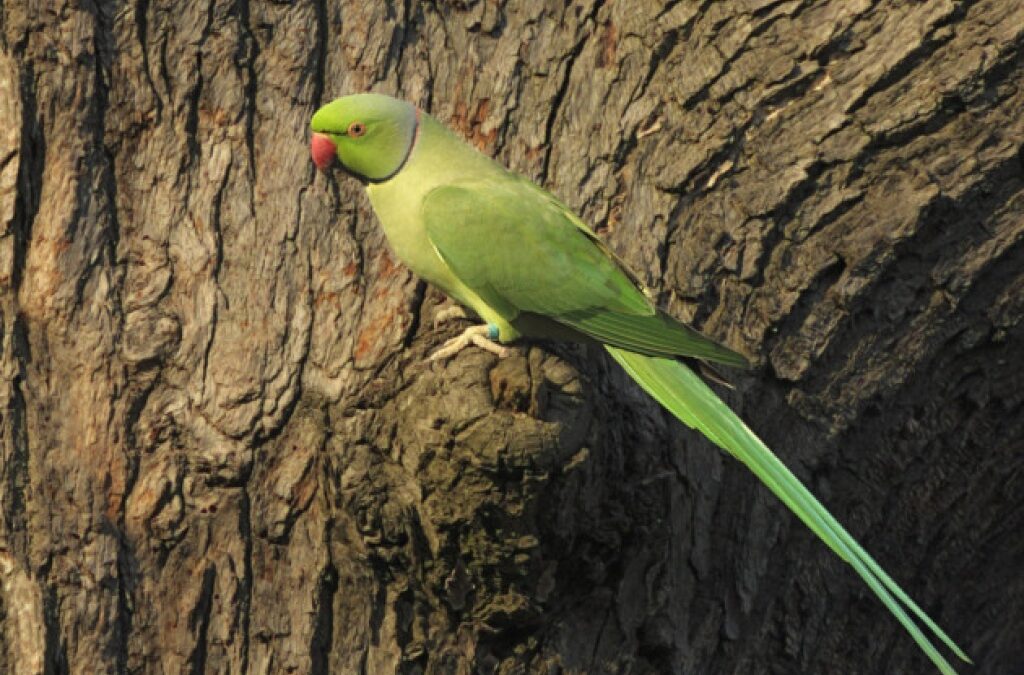Sarratt Parakeets….

Just recently, in fact the last few days a new flock has been swooping and screeching over the fields and trees of the Church end of Church lane. They are pretty and fun to watch but I thought they lived in Hampstead! It seems Sarratt is now the new place to fly. I counted at least thirty yesterday afternoon. Missing the swallows, so it was lovely to watch them even if they are rather rowdy at times!
They are Parrot’s aren’t they? Wild ones! …….
More precisely known as the ring-necked parakeet or rose-ringed parakeet this bright green parrot has taken up residence in many urban and sub-urban parks and gardens across southeast England. The chances are, that if you live in the St Albans area you will have seen them, maybe even in your garden. They are not afraid to make their presence known with constant loud screeching calls uttered both in flight and perched.
Getting a closer look at these birds however is not always as easy as you might imagine for such a garish and noisy bird. Once perched in a large tree their green plumage blends remarkably effectively with the surrounding foliage leaving you searching the canopy while being deafened by a constant screeching! Of course, if you have bird feeders in your garden with nuts and seeds, you may be able to tempt them down into full view where they will display their parrot qualities by clinging upside down and any which way then can to feed. One of the best places to see them doing this is on the bird feeders at the Watercress Wildlife Association nature reserve off Riverside Road in St Albans where six or seven parakeets can often be seen feeding together.
The ring-necked parakeets have certainly brought a welcome taste of the exotic to our parks and gardens but they do come with a slight health warning. Officially they have been classed as a “non-native invasive species” and this puts them on a government and environmental bodies’ watchlist of species that may potentially prove to be a threat to our native wildlife and ecology. This list has serious implications for invasive species and if deemed a threat ring-necked parakeets could face an eradication program not dissimilar to the one enacted on their close cousins, the monk parakeets in 2011. Monk or quaker parakeets had successfully established a breeding colony in Borehamwood but, because of the parakeet’s destructive feeding and nesting habits, they were deemed too great a threat to local crops and infrastructure and were trapped, re-homed as pets or shot.
So far ring-necked parakeets have not proved to be a threat though monitoring is ongoing as their population continues to spread rapidly. Their preference for nesting in tree-holes has raised questions about competition with our other native tree-hole nesting birds such as woodpeckers, nuthatches and starlings, some of which are already under threat from population decline. Questions have also been raised about the impact of noisy and messy parakeet roosts in southwest London where more than 6,000 birds congregate in one place to roost!
Hopefully, while limited culls cannot be ruled out in the future, the parakeets will continue to blend in, albeit noisily, with our English landscape. It is, after all, we who brought them here as captive cage birds from their native homeland: an arid tropical belt of countryside stretching from West Africa across India to the south of the Himalayas. That these birds have adapted to our colder climes and seem quite content to settle down in our big old oak trees is quite remarkable in its self. Personally, I find them a cheery addition, bringing a new variety and vibrancy to our parks and gardens. However, their presence here reminds us once again of the complex interactions between our activities as humans and their consequences for our native wildlife.
Hope Sarratt makes them welcome!
Angela Coakley